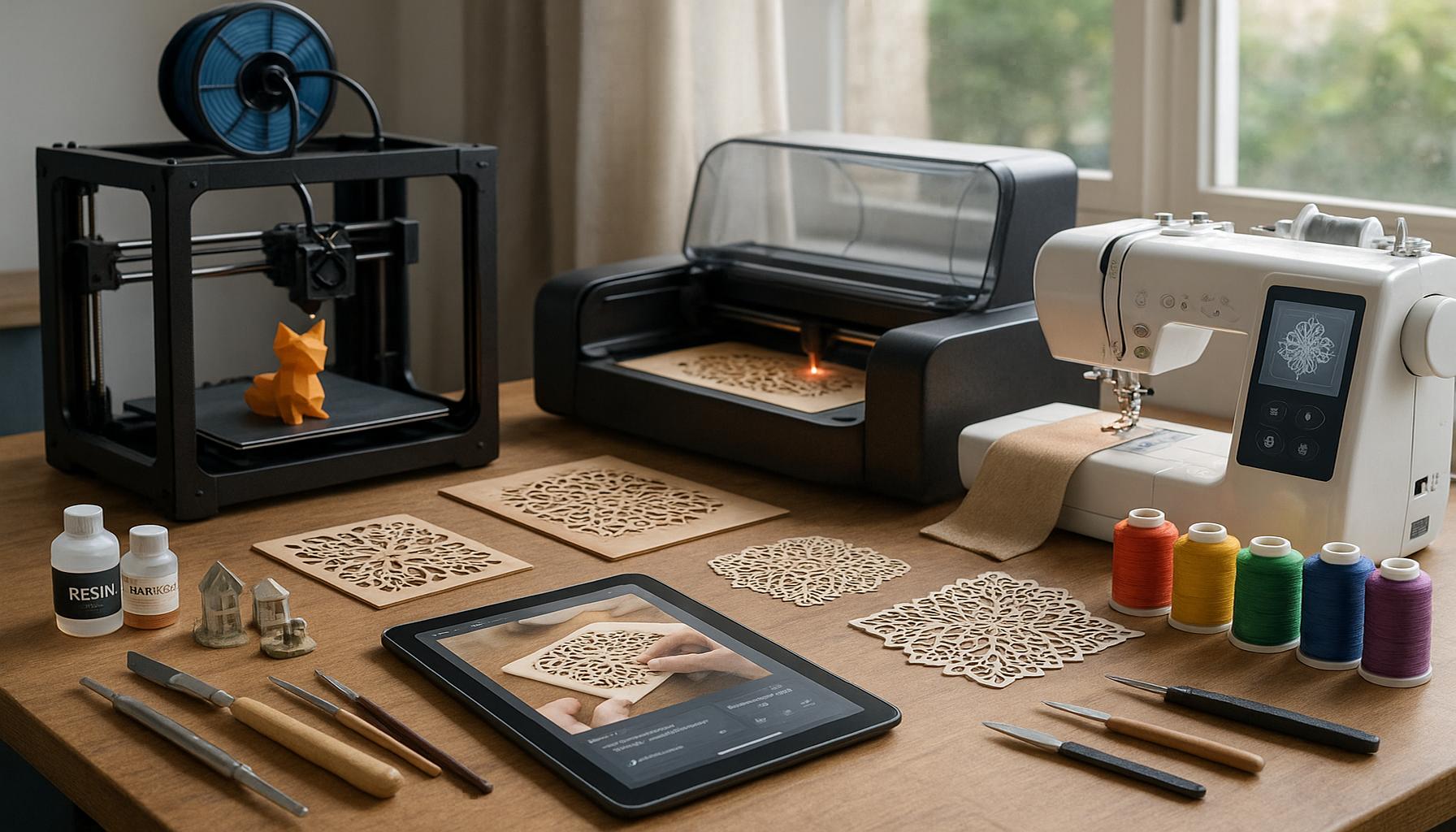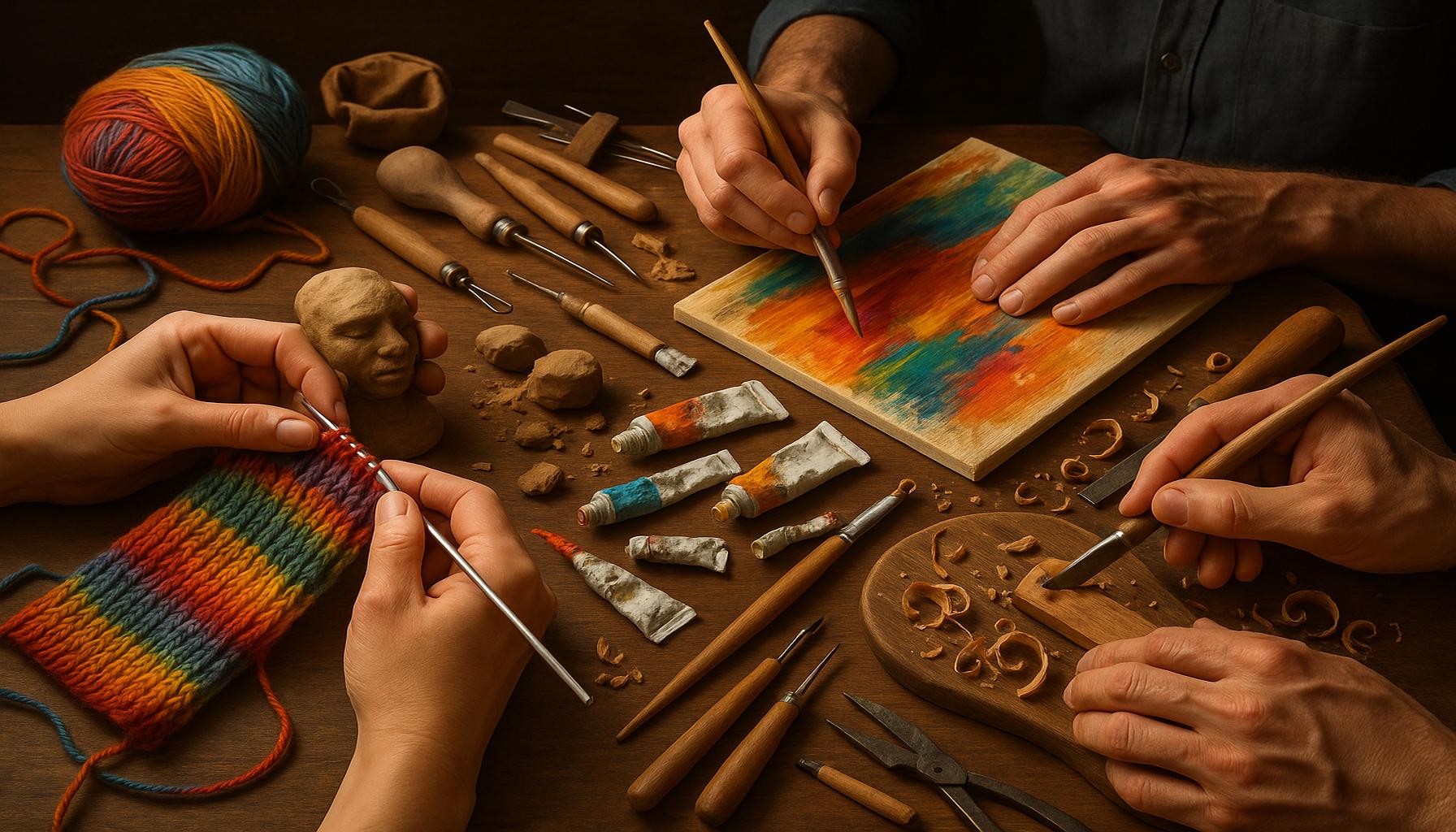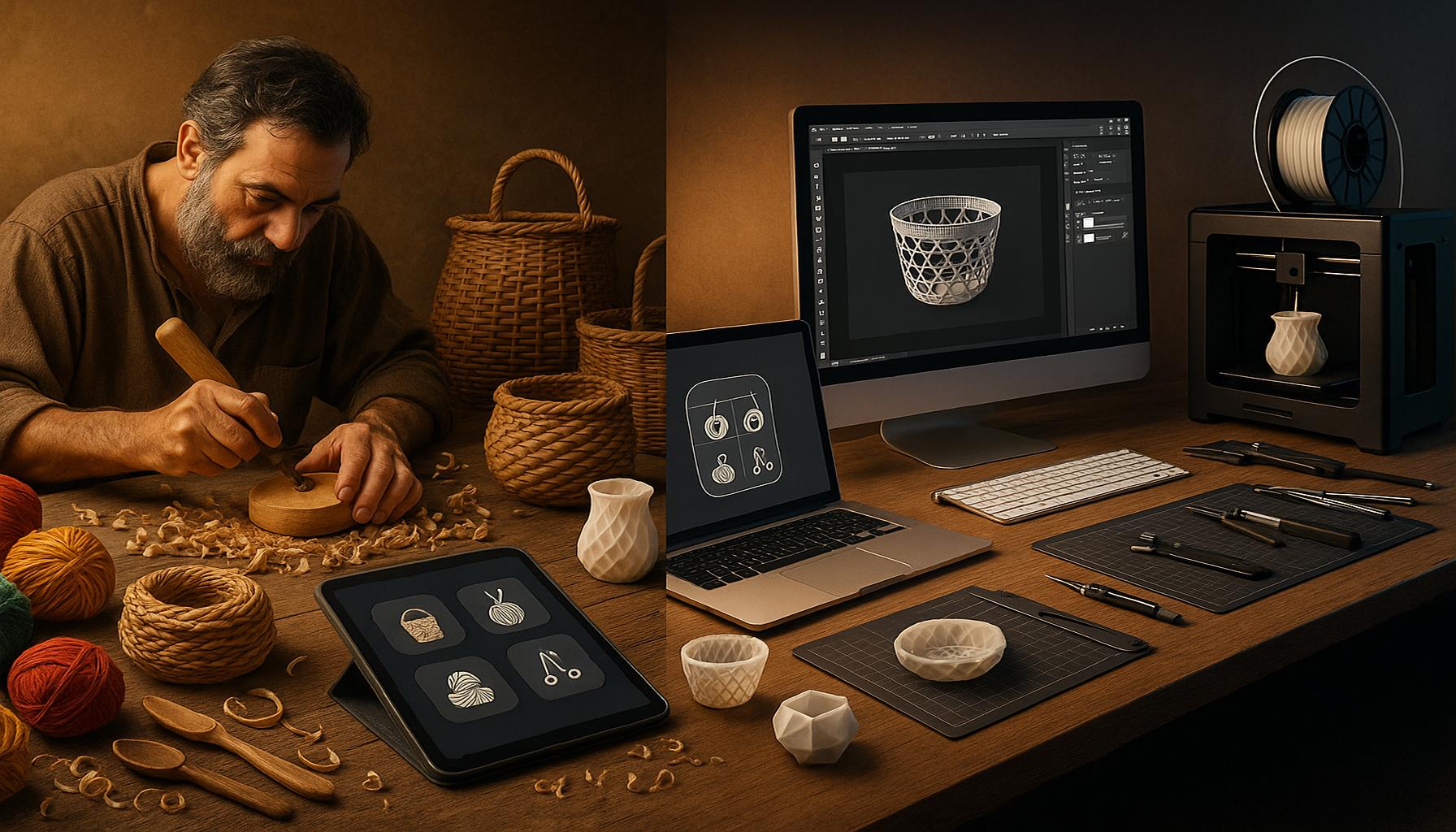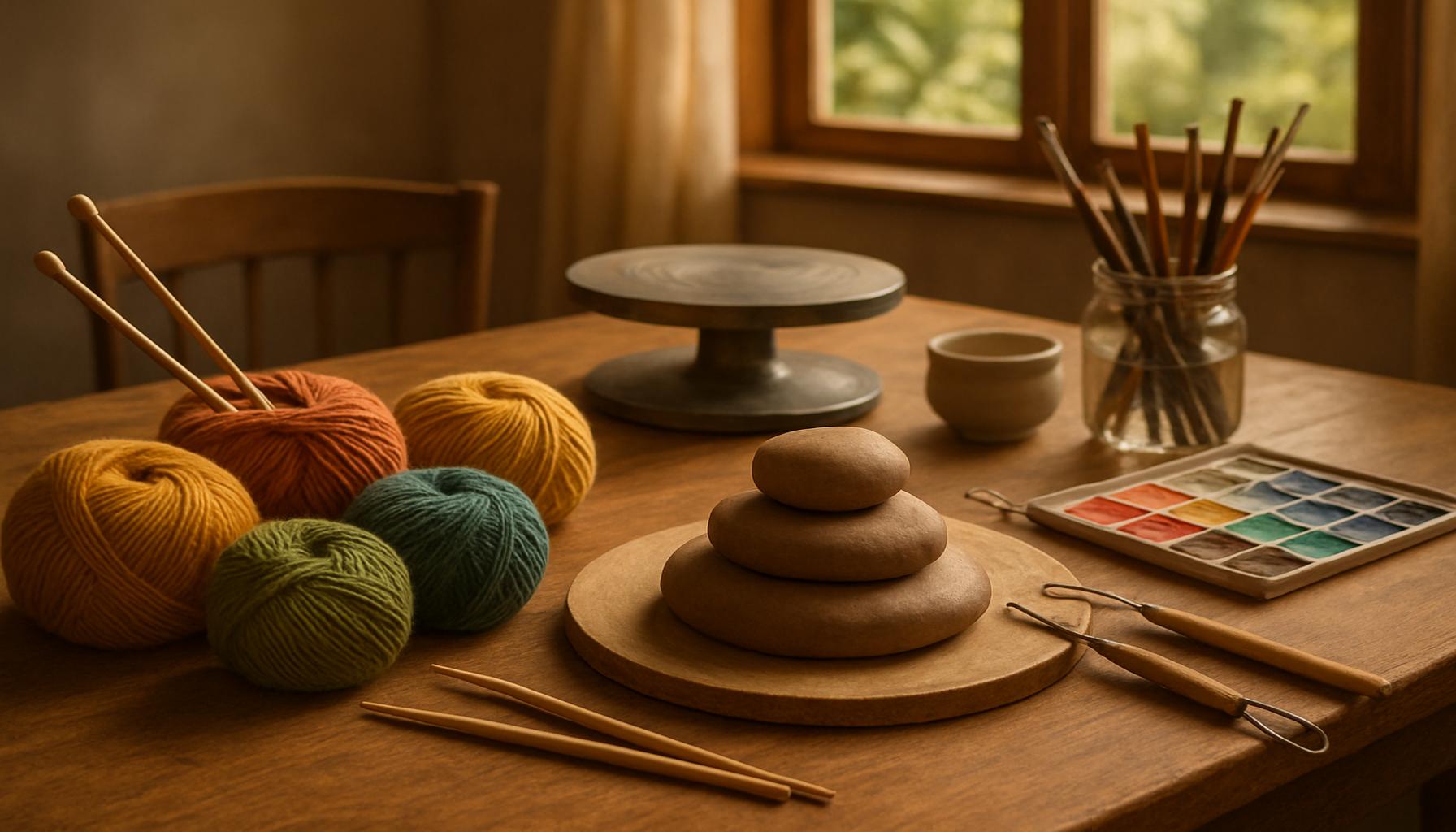Innovations in Crafting: How Technology is Transforming Creative Hobbies

A New Era in Crafting
The landscape of crafting is undergoing a remarkable transformation, predominantly driven by technological advancements that bridge the gap between creativity and accessibility. As innovative tools enter the scene, they empower creators of all backgrounds, whether they’re seasoned artists or enthusiastic beginners, to push their creative boundaries in ways once thought unimaginable.
3D Printing: Precision Meets Imagination
3D printing has revolutionized the way crafters design and produce intricate items. With a 3D printer, creators can translate their digital designs into tangible objects, from customized jewelry pieces to functional home decor. The use of materials such as plastic filaments and even biodegradable options allows for sustainable crafting. For example, a hobbyist might design a complex geometric vase or a personalized phone stand, showcasing both their technical skill and artistic flair. As community makerspaces increasingly offer access to 3D printers, hobbyists can experiment without the high costs typically associated with purchasing professional equipment.
Laser Cutters: Elevating Detail
The advent of laser cutting technology is another exciting development. These machines provide detailed engraving and cutting capabilities across a variety of materials including wood, acrylic, and leather. An artist can create delicate designs that would be exceedingly difficult to achieve by hand. For instance, personalized wedding favors or intricate home decor pieces can be produced with an extraordinary level of detail. By optimizing efficiency, laser cutters also save precious time for busy crafters who want to produce high-quality items in short periods.
Online Platforms: Crafting Connections
In this digital age, online platforms like Etsy and Pinterest have become indispensable for crafters. Etsy empowers individuals to market their handcrafted goods to a global audience, facilitating entrepreneurship and the sharing of unique creations. Pinterest serves as a digital inspiration board, enabling users to explore millions of craft ideas and tutorials. This sense of community fosters collaboration and encourages creators to share techniques and tips, forming connections that span the globe.
Augmented Reality: Crafting in a Virtual Space
Augmented reality (AR) is also reshaping the crafting experience. By employing AR technology, users can visualize how products such as jewelry or home decor will look in their own space before making a purchase. This immersive experience significantly enhances decision-making, thereby reducing returns and increasing satisfaction. Imagine trying on a pair of earrings virtually or visualizing a new art piece hanging on the wall — these innovations make the crafting process more engaging and informed.
Smart Sewing Machines: A New Assistant in Crafting
Sewing machines with smart technology are facilitating sewing projects in unprecedented ways. Many modern machines come equipped with features such as automatic threading, built-in patterns, and connectivity to design software that can upload sewing designs directly to the machine. This means that complex stitching techniques are simplified, allowing even novice sewists to produce professional-quality garments and accessories with relative ease.
As technology continues to evolve, so too do the opportunities for creators in the crafting world. The convergence of traditional artistry with modern tools not only enhances the creative process but also democratizes crafting for a broader audience. Embracing these advancements inspires individuals to explore their artistic talents, making crafting a dynamic and ever-exciting pursuit that is well within anyone’s reach.
DIVE DEEPER: Click here to discover more about musical composition
Transforming Traditional Techniques
The integration of technology into crafting is not merely an addition of tools; it signifies a fundamental shift in how artisans approach their creative processes. The traditional methods that once defined this space are being enhanced and sometimes redefined through innovative technologies. These developments are enabling artists and hobbyists to refine their skills, explore new techniques, and produce high-quality crafts that appeal to modern consumers.
Digital Design Tools: Unleashing Creativity
Digital design software has become a cornerstone for many crafters, facilitating an explosion of creativity. Programs like Adobe Illustrator, Canva, and Silhouette Studio enable users to create intricate designs that are readily transferrable to various crafting mediums, from print to fabric. These tools allow crafters to:
- Design custom graphics for t-shirts, cards, and home decor.
- Edit and manipulate images with precision.
- Access a vast array of templates and tutorials that guide their creative journey.
The ease of digital design makes it accessible for everyone, even those without formal art training. For instance, a parent looking to create a personalized birthday banner can quickly design it from home, thus elevating the quality of their handmade gifts and celebrations.
Social Media: Where Inspiration Meets Digital Sharing
Social media platforms have emerged as vital tools for the crafting community, turning hobbies into social phenomena. Sites like Instagram, TikTok, and Facebook are not only platforms for showcasing finished projects but also venues for learning and collaboration. The rise of influencer crafters has given rise to a wealth of tutorials, DIY videos, and crafting challenges, making it easier than ever for enthusiasts to engage with the community.
- Tutorials allow users to replicate techniques at their own pace.
- Live-streamed crafting sessions offer immediate feedback and interaction.
- Online crafting communities foster support and healthy feedback, essential for growth.
These interactions not only spark ideas but also encourage the sharing of skills and techniques, cultivating a culture of learning and innovation that drives the crafting landscape forward.
Smartphone Applications: Crafting at Your Fingertips
The availability of mobile applications designed specifically for crafters further illustrates the movement towards technology-driven creativity. These applications offer features that include pattern design, project organization, and even inventory management for supplies. Examples such as Craftybase and Stash2Go allow users to keep track of their materials, plan projects effectively, and even calculate costs, streamlining the crafting process significantly.
With mobile technology turning smartphones into powerful creative tools, crafters can now find inspiration, manage their projects, and enhance their skills all from the palm of their hand. Whether they are waiting for a bus or lounging at home, these apps ensure that creativity is always within reach, encouraging spontaneous bursts of artistic expression.
As crafting continues to evolve through technology-driven innovations, the potential for creators is limitless. The incorporation of digital tools, social platforms, and smartphone applications not only enhances the crafting experience but also paves the way for a future where creativity knows no bounds.
Revolutionizing Creative Hobbies
The landscape of crafting and creative hobbies has undergone a remarkable transformation in recent years, largely fueled by technological advancements. 3D printing, for instance, has allowed hobbyists to move beyond traditional materials, enabling them to create intricate designs that would be nearly impossible to achieve by hand. This technology not only saves time but also reduces waste, as crafters can precisely control their materials, producing components on demand.Similarly, the rise of online platforms has provided crafters with access to a global community. Websites and social media channels dedicated to various forms of craft allow enthusiasts to share tips, tutorials, and innovative ideas. This exchange of knowledge encourages a more collaborative environment, where techniques and inspiration are just a click away, further pushing the boundaries of traditional crafting.In addition, software solutions for design and planning have made it easier for crafters to visualize their projects before materializing them. Programs that assist in layout planning or pattern design can provide both novice and seasoned creators with the confidence they need to experiment with new concepts.Furthermore, the integration of augmented reality (AR) in crafting is beginning to make waves. Applications are being developed that allow users to see designs in their real-world environment before committing to a project. This feature not only enhances the user experience but also minimizes the potential for errors.As technology continues to evolve, the possibilities for crafting are virtually limitless. From smart tools that enhance precision to interactive online communities that connect creatives, these innovations serve not just to simplify the crafting process but also to enrich the experience itself. The next generation of crafters is armed with tools that empower their creativity like never before, raising the bar for what can be accomplished in the world of DIY and crafting.
| Category | Advantages |
|---|---|
| 3D Printing | Facilitates complex designs and reduces material waste. |
| Online Communities | Fosters knowledge sharing and collaboration among crafters. |
| Design Software | Helps visualize projects and enhances the creative process. |
| Augmented Reality | Allows users to preview designs before execution, reducing errors. |
The fusion of technology and crafting not only revitalizes traditional hobbies but also invites an audience of new enthusiasts eager to explore the creative possibilities technology enables. The excitement surrounding these innovations continues to grow, making it an exhilarating time for crafters everywhere.
DIVE DEEPER: Click here to discover the magic of musical composition
Redefining Crafting Communities
The advent of technology has not only transformed the tools of the crafters; it has also redefined the way crafting communities operate and interact. This evolution is particularly notable in how crafters connect with each other, share knowledge, and support one another’s creative journeys. The rise of online platforms has created a vibrant ecosystem where crafters no longer feel isolated in their hobbies but are instead part of a global network of like-minded individuals.
Online Marketplaces: A New Avenue for Artisans
With the rise of e-commerce platforms like Etsy and Shopify, artisans can showcase their creations and reach customers far beyond their local communities. These online marketplaces have democratized the ability to sell handmade goods, allowing crafters to turn their hobbies into viable businesses. This development has given rise to:
- A larger reach for unique, handcrafted products that appeal to niche markets.
- An avenue for crafters to engage directly with consumers, receiving feedback and building relationships.
- Tools for marketing, pricing, and shipping that simplify the business process.
For example, an artisan creating handmade wooden toys can easily set up an online store, engage with customers through social media, and even participate in virtual craft fairs—all contributing to the growth of their brand and craftsmanship.
3D Printing: Revolutionizing Prototyping and Customization
The technology of 3D printing has also made significant waves in the crafting world, transforming how designers and makers prototype their ideas. This innovative technology allows crafters to create physical objects from digital designs, blurring the lines between imagination and reality. The benefits of integrating 3D printing into crafting include:
- The ability to create complex shapes and structures that were previously impossible to fabricate by hand.
- Customization options, enabling crafters to produce one-of-a-kind items tailored to specific clients or personal preferences.
- A faster prototyping process, allowing artisans to test and iterate their designs quickly.
Through the use of 3D printers, a jewelry designer can now produce intricate designs directly from their computer, experimenting with styles and materials that enhance the final product while reducing waste.
Augmented and Virtual Reality: Crafting Experiences Transformed
Augmented reality (AR) and virtual reality (VR) are emerging technologies that further enhance the crafting experience. These advancements allow crafters to visualize projects in a simulated environment before creating them physically. By utilizing AR apps, a crafter may overlay digital patterns onto real-world surfaces, helping them to envision how a finished piece will look.
Similarly, VR platforms can offer immersive crafting classes or tutorials, where users feel as if they are physically in a workshop alongside skilled instructors. The possibilities include:
- Engaging crafting experiences that bridge the gap between design and execution.
- Access to virtual workshops featuring industry professionals from around the globe.
- A gamified approach to learning new crafting techniques, making skills acquisition more enjoyable.
As crafters engage with these technologies, the landscape of creative hobbies is likely to continue evolving. No longer confined by traditional methods, artists are now able to express themselves in unparalleled ways, capitalizing on the innovations that technology has ushered into the crafting world.
DISCOVER MORE: Click here for creative techniques to unwind
Conclusion: Embracing the Future of Crafting
In conclusion, the intersection of technology and crafting has resulted in a profound transformation of creative hobbies, bringing with it exciting innovations that empower artisans like never before. From the rise of e-commerce platforms that allow crafters to monetize their passions and connect with consumers worldwide, to the game-changing capabilities of 3D printing that enable detailed prototyping and customization, the avenues for creative expression have multiplied significantly.
Moreover, augmented and virtual reality are opening doors to immersive learning experiences, allowing crafters to visualize their projects and participate in global workshops from the comfort of their homes. This combination of enhanced tools and collaborative platforms has created a supportive community that fosters learning and growth, breaking down geographical barriers.
As technology continues to evolve, it will undoubtedly further influence the crafting landscape, giving rise to new materials, techniques, and possibilities that we have yet to imagine. By embracing these innovations, creators not only enhance their skills but also ensure that their crafts remain relevant in a fast-changing world. For those passionate about their creative journeys, the future of crafting is not just about keeping up with trends; it’s about pioneering new forms of self-expression and community. As we look forward, the only limit will be our imagination, encouraging crafters to explore, innovate, and share their craft like never before.


